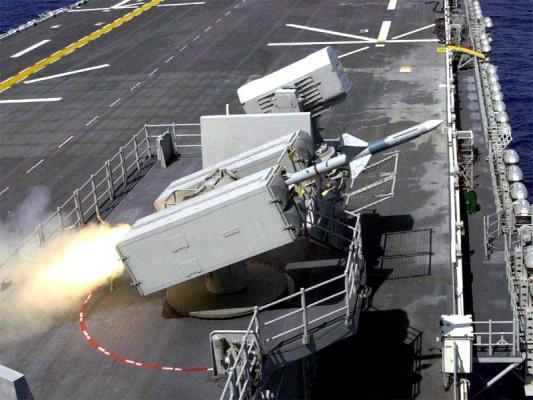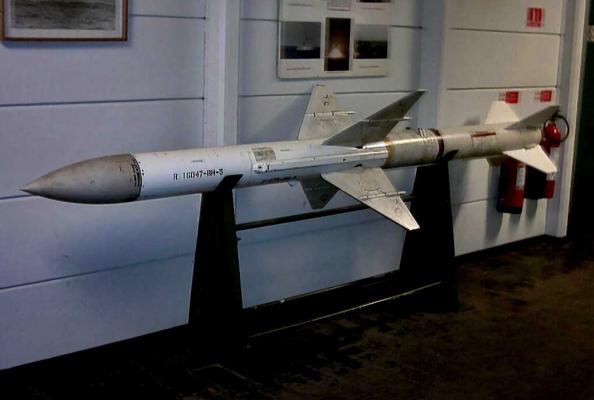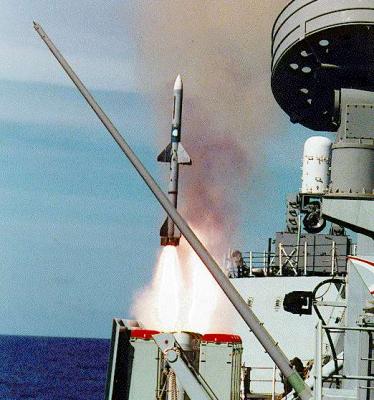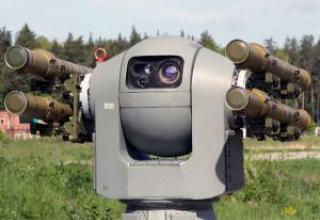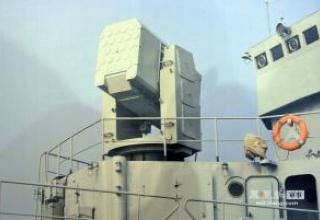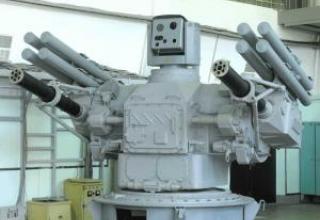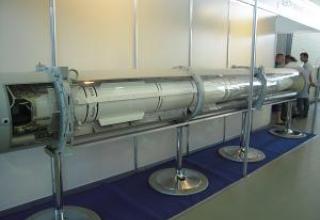Sea Sparrow ship anti-aircraft missile system (SAM system) is designed to organize air defense of surface ships from aircraft, helicopters and low-flying enemy cruise missiles in the short range. Sea Sparrow SAM system of various modifications is one of the most massive anti-aircraft systems of the NATO Navy. The complex is designed primarily for surface ships of small displacement, for which significant size restrictions on the weapons deployed, as well as to strengthen the air defense of large ships at short ranges.
The complex was created as a result of work carried out since 1964 under the program BPDMS (Basic Point Defense Missile System) on the basis of a modified air-to-air missile Sparrow-III AIM-7F. Tests of the basic version of the complex with the control system Mk 115 and target illumination radar Mk 51 were conducted since February 1967. During 1971-75, the complex was installed on 31 U.S. Navy ships.
In 1968 the complex was installed on 31 US Navy ships. Denmark, Italy and Norway came to an agreement with the U.S. Navy on joint activities to upgrade Sea Sparrow SAM systems as part of international cooperation - NATO SeaSparrow Project Office (NSPO). NSPO started implementation of the IBPDMS (Improved Basic Point Defense Missile System) program for development of a unified air defense tool for surface ships of NATO countries. The new complex, designated NSSMS Block I (NATO Sea Sparrow Missile System), successfully passed the tests, the serial production began in 1973.
Over the long years of service the complex has been repeatedly modernized and is now adopted by the Navy of many countries. Albatros SAM system developed by Alenia Marconi Systems and installed on ships of Italy, Morocco and Egypt is a localized version of NSSMS Sea Sparrow.
At present, a new RIM-162 ESSM (Evolved Seasparrow Missiles) anti-aircraft missile is offered to replace the RIM-7 missile of various modifications in the Sea Sparrow SAM system. The development of the RIM-162 ESSM began in 1995 by an international consortium led by Raytheon. It consists of a consortium of companies from Australia, Belgium, Canada, Denmark, Greece, the Netherlands, Italy, Norway, Portugal, Spain, Turkey and the USA. The new missile can be launched from both rotary and vertical launchers of Sea Sparrow complex.
Composition:
Sea Sparrow's first modifications include: AIM-7F guided missile, Mk115 control system with Mk51 target illumination radar (see photo), Mk25 8 SAM launcher (modified ASROC) and ammunition cellar. The total mass of the SAM system reaches 17.7 t.
ZUR AIM-7F - single-stage, with a Rocketdyne Mk38 mod 2 RDT march is equipped with a semi-active radar homing head. The complex works in the following way. After detection of a target, data about it from the combat information post are fed into the Mk115 control system. The Mk51 X-band radar included in the Mk115 control system provides target illumination. The radar antenna station is mounted on a pivoting base and is connected to the movable part of the launcher by means of tracking drives. Operating experience of the basic version of the SAM system revealed a number of serious shortcomings of the complex, which were associated primarily with the weak power of the marching engine of the AIM-7F missile, significant transverse dimensions of the missile due to the non-deployable wings, the low level of automation of combat work and insufficient efficiency of the control system Mk115 at night and in bad weather.
The NSSMS Block I (Nato Sea Sparrow) received a new RIM-7H missile with a folding wing, an upgraded compact launcher Mk 29, a new target illumination radar SPS-65 and an automated control system Mk91 (see photo). The RIM-7H air-to-air missile was created on the basis of the AIM-7E2 air-to-air missile specially for use in the anti-aircraft system. The RIM-7H missile was equipped with an improved homing head and a new Aerojet engine Mk52 mod2 (engine weight - 68.5 kg, operating time 2.8s). The RIM-7H homing system used the Mk91 control system of mod0 and mod1 modifications. At the moment RIM-7H is removed from the armament.
In 1972, the Raytheon company began producing a new version of the AIM-7F aircraft missile. The onboard control system of the new missile was based on solid-state electronics. Significant reduction of weight and dimensions of the control system allowed to move the combat unit to the nose of the missile, increase the weight of the BC and apply a marching engine of enhanced energy. The new missile adapted for the ship's Nato Sea Sparrow was launched under the designation RIM-7F.
In 1983, the NSSMS system received a new means of destruction - missile RIM-7M. RIM-7M has a new monopulse jamming homing head, which provides reliable engagement of low-flying targets, autopilot, providing the flight of the missile to the point of aim at the loss of target, fully digital control system and an upgraded combat unit WAU-17. The RIM-7M is equipped with a Hercules Mk58 engine.
Since 1991 the deliveries of the RIM-7P missile as part of the NSSMS SAM system have started. RIM-7P is produced by the cooperation of Raytheon, General Dynamics and Hughes Missile Systems (the beginning of development - 1987), is equipped with a new impulse Doppler Semi-Activating Radar and allows to attack targets from above on the background of the underlying surface. With the adoption of the RIM-7P complex Nato Sea Sparrow was able to attack surface targets.
The last representative of the RIM-7 family of missiles is RIM-7R (1997). RIM-7R homing system is equipped with an additional thermal imaging channel. Complexing the homing channels has significantly increased the noise immunity of the RIM-7R, however, because of the high cost of the development program RIM-7R was closed.
To control missiles RIM-7R last modifications used control system Mk91 mod2 and Mk91 mod3. Mk91 mod2 provides target firing for one SAM, Mk91 mod3 for two targets by successive launches of one SAM or one target by two missiles. The Mk91 mod3 can be used in conjunction with the Mk23 TAS early detection system, which is used to display tactical situation, target distribution and target designation, including for other carrier ship combat systems. Together, they form the AN-SWY-1(V) self-defence system. The Mk95 is a standard target tracking and illumination radar, but the control system is coordinated with other radars for similar purposes.
The Mk29 launchers provide storage, pointing and launching of eight RIM-7 sounders of all modifications, as well as RIM-162 ESSM missiles. Recharge is performed manually (see photo). The Mk29 is equipped with the following frigates: type Wieligen (Belgian Navy), type Bremen-F122 (German Navy), types Tromp , Kontenaer and Jacob van Heemskerck (Dutch Navy), type Oslo (Norwegian Navy), type Vasco da Gama (Portuguese Navy), type Yavuz (Turkish Navy). The Nimitz class aircraft carriers have three Mk-29 paired launchers, one of which is located in the bow on the right side of the sponsor, and two of which are located at the aft deck below the flight deck. U.S. Navy Strike Carrier George H.W.Bush is armed with two Mk-29 twin rocket launchers for RIM-162 missiles.
The incoming Mk29 launchers are unable to provide the necessary firing rate and reaction time for the massive use of enemy air attacks. To eliminate this drawback, modifications of Nato Sea Sparrow SAM systems with Mk41 vertical launch rocket launchers (see description) and Mk48 of various versions (see description) have been developed.
For use as part of a vertical launch vehicle, the RIM-7 rocket is equipped with a special block of Jet Vane Control (JVC) gas rudder, which is placed on the nozzle block of the marching RDTT. JVC unit provides automatic inclination of the rocket towards the target after the launch and is reset after the maneuver. The weight of the JVC unit is 15.8 kg and includes: four steering devices, control system, microprocessor, analog converters, autonomous ignition system, and a battery (power supply). The JVC provides the ability to point the missile after its release from the launcher at speeds up to 283 degrees / s. The RIM-7 is paired with the launch vehicle via the MIL-STD 1553 bus of the upgraded Mk41 and Mk48 PU.
The Mk41 vertical missile launch system is deployed on ships in various configurations: from a single module with eight cells to 16 with 128 cells.
On Australian frigates like Anzac the eight-container Mk41 mod5 launcher (see photo) is placed in the superstructure behind chimneys. The frigates of Brandenburg type (project 123) are equipped with 16 chargers Mk41 mod4 at the nose end of the superstructure. The Mk41 mod5 PU is also fitted with Naresuan type frigates of the Thai Navy. The 16-charged Mk41 mod8 is installed on Turkish frigates of Barbaros type (MEKO 200TN project).
Characteristics:
| Maximum firing range, km | 19 (50 ESSM) |
| Height of target hit, m | 8-15000 |
| Dimensions of the rocket RIM-7 (M,P), mm: - length - diameter - wingspan |
3640 203 1000 |
| Maximum missile flight speed, M | 2.5-3 |
| Starter weight, kg | 225 |
| Weight of combat unit, kg | 40.5 |
Testing:
The first successful test of a SCALP RC with a conventional control system took place in southwest France in late December 2000. The rocket successfully hit a specially built target at maximum range in bad weather conditions.
